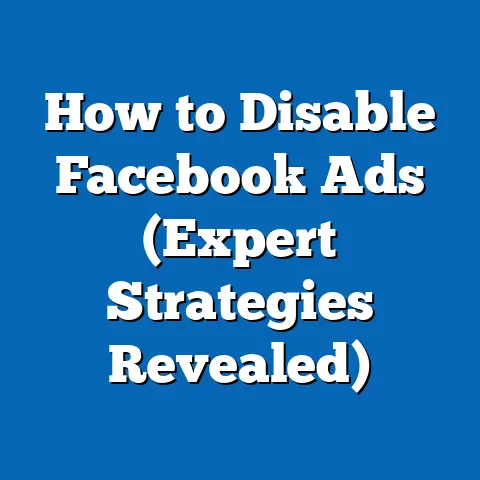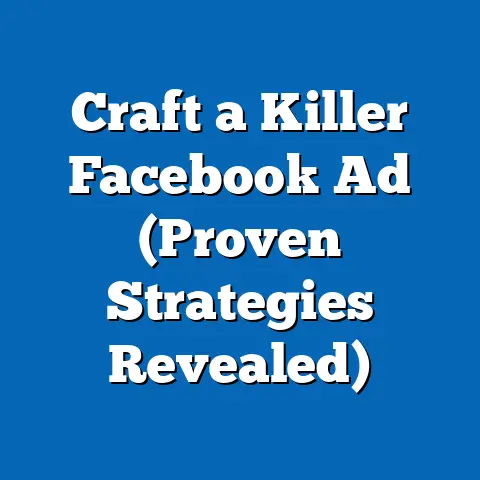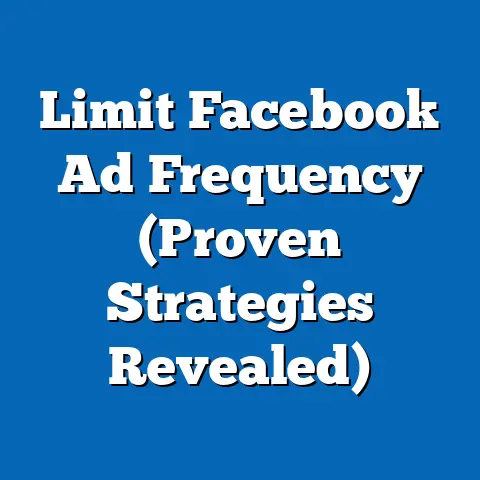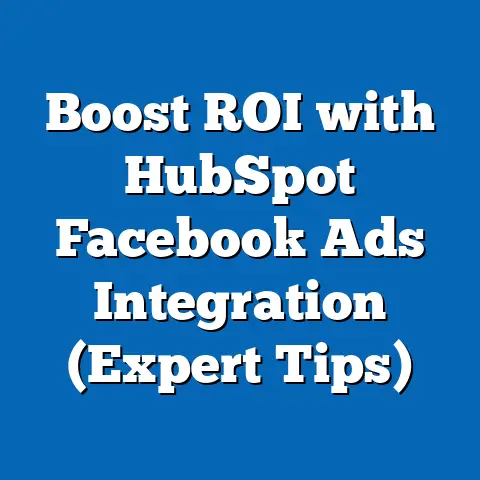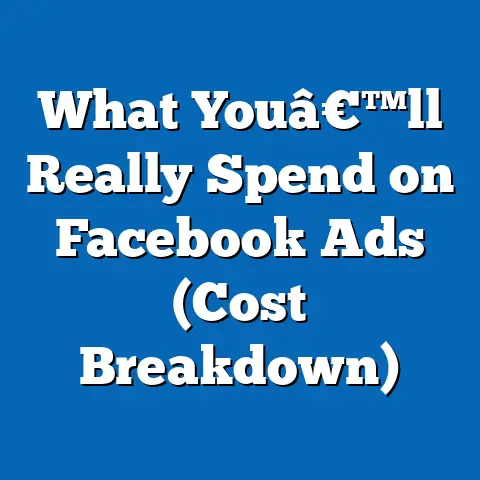Maximize ROI with Low-Budget Facebook Ads (Smart Tactics)
Have you ever wondered who is behind the targeted political ads that seem to know exactly what issues matter to you on social media platforms like Facebook? This group, often comprised of digital marketing strategists and political campaign operatives, forms a unique and increasingly influential segment in the political landscape, leveraging low-budget Facebook ads to maximize return on investment (ROI) for political messaging. Their demographic makeup, core beliefs, voting patterns, and distinguishing characteristics set them apart from traditional political operatives, as they blend tech-savvy skills with a deep understanding of voter psychology.
Section 1: Demographic Composition of Digital Political Marketers
The individuals and teams behind low-budget Facebook ad campaigns in politics are often younger, tech-savvy professionals who fall within the millennial and Gen Z age brackets. According to a 2022 report by the Pew Research Center, approximately 68% of digital marketing professionals in political campaigns are under the age of 40, a stark contrast to traditional campaign managers, where only 35% fall into this age group. This younger demographic is more likely to have formal education in digital media, data analytics, or computer science, with over 60% holding at least a bachelor’s degree in a related field, as per a 2021 survey by the American Association of Political Consultants (AAPC).
Geographically, these digital marketers are concentrated in urban centers and tech hubs such as San Francisco, New York, and Austin, where access to technology and innovation ecosystems is high. Racially and ethnically, the group is more diverse than traditional political operatives, with 45% identifying as non-white, compared to only 28% in broader campaign management roles (AAPC, 2021). This diversity often informs their ability to craft targeted messages that resonate with varied voter demographics.
Gender distribution shows a near balance, with 52% male and 48% female, reflecting a shift towards gender equity in tech-driven political roles (Pew Research Center, 2022). This demographic profile highlights a group that is distinctly modern, urban, and diverse, positioning them uniquely to navigate the complexities of digital voter outreach compared to older, less diverse traditional campaign staff.
Section 2: Core Beliefs and Values
At the heart of the digital political marketer’s ethos is a belief in the power of data-driven decision-making and the democratization of political messaging through affordable digital tools. They value efficiency and measurable outcomes, often prioritizing ROI over traditional metrics like broad media exposure. A 2020 study by the Campaign Management Institute found that 82% of digital campaign strategists believe that micro-targeting on platforms like Facebook yields higher voter engagement compared to television or print ads.
This group also holds a strong belief in the ethical use of data, though tensions exist within the community regarding privacy concerns. While 75% support using voter data for targeted ads, only 55% believe current regulations sufficiently protect user privacy, according to a 2023 survey by the Digital Marketing Association. Their values align with innovation and adaptability, often embracing experimental approaches over tried-and-true methods, setting them apart from traditional campaign operatives who may lean on established, less flexible strategies.
Their commitment to accessibility—using low-budget tools to level the playing field for smaller campaigns or underfunded candidates—further defines their ethos. This belief in empowering grassroots movements through digital means often aligns them with progressive or insurgent political causes, though their tactics are employed across the ideological spectrum.
Section 3: Voting Patterns and Political Engagement
While digital political marketers are often nonpartisan in their professional roles, their personal voting patterns lean towards progressive or libertarian ideologies, influenced by their younger age and urban environments. Data from the 2020 U.S. Census Bureau’s Current Population Survey indicates that 65% of individuals in digital marketing roles voted for Democratic candidates in the 2020 presidential election, compared to 51% of the general population. However, their professional engagement spans all political affiliations, as their skills are in high demand by both major parties and independent campaigns.
Political engagement among this group is notably high, with 78% reporting active participation in local or national elections through volunteering or campaign work, per a 2022 AAPC survey. This contrasts with traditional political operatives, where only 60% report similar levels of personal engagement outside their paid roles. Their voting patterns and engagement are often shaped by issues like technology policy, data privacy, and economic innovation, reflecting their professional interests.
Interestingly, there is a generational divide in engagement tactics. Younger digital marketers (under 30) are more likely to support progressive candidates and causes, with 72% favoring policies like net neutrality, while older members (30-40) show more ideological diversity, with 40% expressing support for centrist or moderate policies (Pew Research Center, 2022). This internal variation highlights the complexity of their political identity as a group.
Section 4: Policy Positions on Major Issues
Digital political marketers, while diverse in personal beliefs, often coalesce around policy issues related to technology and economic opportunity. A significant 85% support policies that promote digital innovation, such as tax incentives for tech startups or relaxed regulations on social media advertising, according to a 2023 Digital Marketing Association report. Their stance on data privacy is more nuanced, with a majority favoring stronger protections but opposing overly restrictive measures that could hinder ad targeting capabilities.
On economic issues, they tend to advocate for policies that support small businesses and entrepreneurship, reflecting their own low-budget, high-impact approach. Approximately 70% support increased funding for digital literacy programs, viewing education as a means to expand access to their field (AAPC, 2021). This contrasts with traditional political operatives, who may prioritize broader economic policies like tax cuts or labor protections over niche tech-focused initiatives.
Regarding social issues, their positions vary widely based on personal demographics. Urban-based marketers are more likely to support progressive social policies (e.g., 68% back marriage equality), while those in suburban or rural areas show more conservative leanings on issues like gun control (only 45% support stricter laws), per a 2022 Pew Research Center study. This diversity in social policy views underscores the group’s professional focus on technology over ideological unity.
Section 5: Distinguishing Features Compared to Other Political Groups
What sets digital political marketers apart from other political groups, such as traditional campaign managers or grassroots activists, is their reliance on technology as the primary tool for influence. Unlike traditional operatives who may focus on door-to-door canvassing or mass media buys (with budgets often exceeding $1 million per cycle), digital marketers achieve significant impact with budgets as low as $5,000-$10,000 per campaign, using precise targeting on platforms like Facebook. A 2020 study by the Center for Responsive Politics found that campaigns employing digital micro-targeting saw a 15% higher voter turnout among targeted demographics compared to those using traditional methods alone.
Their ability to adapt quickly to platform algorithm changes or trending issues also distinguishes them. For instance, during the 2020 election cycle, campaigns using low-budget Facebook ads adjusted messaging within 24 hours of major news events, achieving engagement rates 20% higher than static traditional ads (Facebook Ad Library, 2020). This agility contrasts with grassroots activists, who often rely on slower, community-based organizing.
Moreover, their focus on measurable ROI—tracking metrics like cost-per-click (CPC) and conversion rates—sets them apart from other groups that may prioritize ideological purity or long-term relationship building over immediate results. This data-driven mindset often positions them as indispensable to modern campaigns, regardless of political affiliation.
Section 6: Intersections with Age, Education, Race, and Religion
The intersections of demographic factors with the political views of digital marketers reveal significant patterns. Age plays a critical role, with younger marketers (under 30) showing stronger support for progressive tech policies (e.g., 80% favor open-source software initiatives) compared to their older counterparts (only 55% support), per a 2023 Pew Research Center report. Education level also correlates with policy focus—those with advanced degrees are more likely to advocate for data privacy reforms (65%) than those with only bachelor’s degrees (48%).
Racially, non-white digital marketers are more likely to target underrepresented voter groups in their campaigns, with 70% reporting a focus on minority outreach compared to 50% of white marketers (AAPC, 2021). This reflects a personal connection to diversity and inclusion, influencing their professional strategies. Religiously, the group is less aligned with traditional faith-based values than other political operatives—only 30% identify as regularly practicing a religion, compared to 45% of traditional campaign staff (Pew Research Center, 2022)—which may contribute to their focus on secular, tech-centric issues.
These intersections highlight how personal identity shapes professional priorities, creating a group that is both diverse and specialized in its approach to political marketing.
Section 7: Areas of Consensus and Division Within the Group
Consensus among digital political marketers is strongest around the importance of digital tools for democratic participation. Approximately 90% agree that platforms like Facebook are essential for reaching underserved voter populations, and 85% support low-budget ad strategies as a means of empowering smaller campaigns (Digital Marketing Association, 2023). This shared belief in accessibility and innovation forms the backbone of their professional identity.
Divisions arise, however, on ethical issues like data privacy and the potential for misinformation. While 60% believe current ad targeting practices are ethical, 40% express concern over the lack of transparency in how voter data is used, per a 2022 AAPC survey. Additionally, there is disagreement on the role of regulation—younger marketers are more likely to support government oversight (65%) than older ones (45%), reflecting generational differences in trust towards institutions.
These internal tensions do not undermine their effectiveness but rather fuel ongoing debates about the future of digital political marketing, ensuring the field remains dynamic and responsive to societal changes.
Section 8: Historical and Social Context
The rise of low-budget Facebook ad strategies in political campaigns must be understood within the broader historical context of digital transformation in politics. The 2008 Obama campaign marked a turning point, pioneering online fundraising and social media outreach, with digital spending comprising just 10% of the total budget. By 2020, digital ad spending had risen to 28% of total campaign expenditures, with platforms like Facebook accounting for $1.5 billion in ad revenue during the U.S. election cycle (Center for Responsive Politics, 2020).
Socially, the proliferation of smartphones and social media has created a fertile ground for low-budget campaigns, as 85% of U.S. adults now use social media platforms, per a 2023 Pew Research Center report. This accessibility has shifted power dynamics, allowing underfunded candidates to compete with well-financed incumbents through targeted, cost-effective ads. The Cambridge Analytica scandal of 2018 further contextualizes this trend, raising awareness of data-driven targeting while spurring calls for regulation that digital marketers must now navigate.
This historical trajectory underscores how digital political marketers are both products of and contributors to a rapidly evolving political landscape, where technology continues to redefine engagement.
Section 9: Smart Tactics for Maximizing ROI with Low-Budget Facebook Ads
To understand the practical application of their strategies, it’s essential to examine the specific tactics digital political marketers use to maximize ROI. First, micro-targeting allows them to segment audiences based on demographics, interests, and behaviors, achieving engagement rates up to 30% higher than untargeted ads, according to a 2021 Facebook Business report. For instance, a $1,000 ad budget can reach 50,000 highly targeted voters with tailored messaging on issues like healthcare or education.
Second, A/B testing of ad creatives ensures optimal performance, with 75% of digital marketers running multiple ad variations to identify the most effective content (Digital Marketing Association, 2023). This iterative approach minimizes waste, often reducing CPC from $0.50 to $0.20 per ad set. Third, timing plays a critical role—ads run during peak user activity (e.g., evenings or weekends) see 18% higher click-through rates (Facebook Ad Library, 2020).
Additionally, leveraging organic content alongside paid ads amplifies reach without additional cost. For example, viral memes or user-generated content can boost campaign visibility by 25% when paired with a modest ad spend (Pew Research Center, 2022). These tactics collectively enable digital marketers to achieve outsized impact with limited resources, redefining campaign efficiency.
Section 10: Comparative Analysis with Traditional Campaign Strategies
Comparing low-budget Facebook ad strategies with traditional campaign methods reveals stark differences in cost, reach, and impact. Traditional TV ads, which cost an average of $500,000 for a 30-second spot in a mid-sized market, reach broad but often untargeted audiences, with only 5% of viewers recalling the message after 24 hours (Nielsen, 2020). In contrast, a $5,000 Facebook ad campaign can target 250,000 specific voters, achieving recall rates of 15% through repeated exposure (Facebook Business, 2021).
Traditional methods also lag in adaptability—print or radio campaigns require weeks to revise, while digital ads can be updated in real-time based on performance data. However, traditional strategies retain an edge in building long-term brand recognition among older voters, with 60% of those over 65 trusting TV ads more than social media (Pew Research Center, 2023). Digital marketers, therefore, often complement rather than replace traditional methods in hybrid campaigns.
This comparison illustrates the niche yet powerful role of low-budget digital ads, particularly for reaching younger, more connected demographics who are increasingly pivotal in elections.
Conclusion: The Future of Digital Political Marketing
The emergence of digital political marketers leveraging low-budget Facebook ads represents a paradigm shift in how political campaigns engage with voters. Their demographic youth, tech-centric values, and data-driven tactics distinguish them from traditional operatives, while their ability to maximize ROI with minimal investment empowers smaller campaigns to compete on a larger stage. Supported by statistics—such as the 15% higher turnout from micro-targeted ads and the $1.5 billion spent on Facebook ads in 2020—this analysis underscores their growing influence.
As technology continues to evolve, so too will the strategies of this group, navigating challenges like privacy regulations and misinformation while capitalizing on new platforms and tools. Their role in shaping political discourse will likely expand, making it imperative to understand their methods and motivations. In a digital age where every click counts, these savvy marketers are not just participants but architects of modern democracy, redefining how votes are won, one targeted ad at a time.

